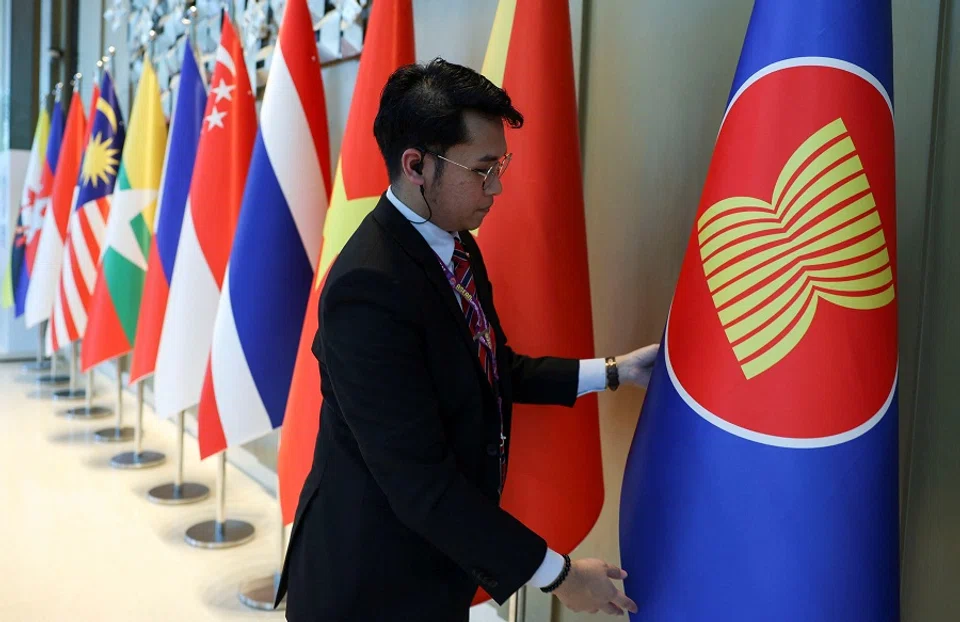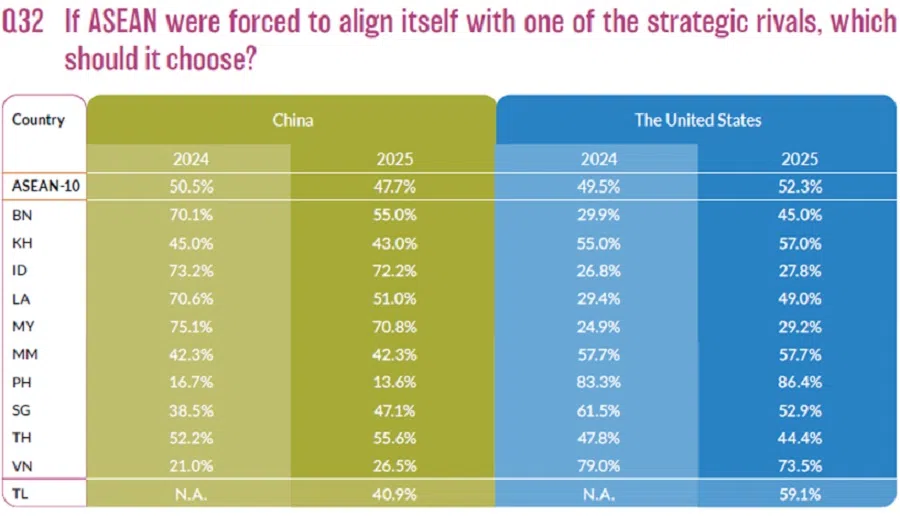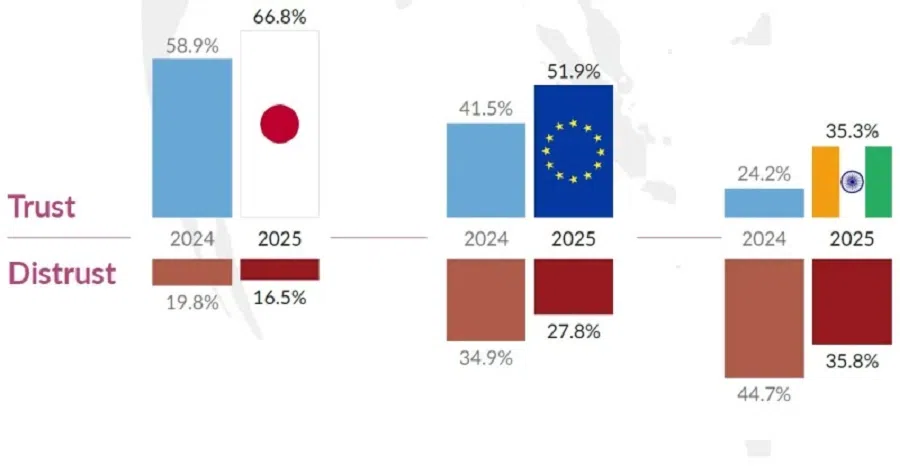State of Southeast Asia Survey 2025: Taking Southeast Asia’s pulse on geopolitics
Some Southeast Asians appear to have warmed to Trump. This could be based on the assessment that his policies might not harm the region as much.

One of the most striking findings of the latest State of Southeast Asia survey is that Southeast Asians have largely taken the actions of the new Trump administration in their stride, as measured by their preference for a Trump-led US over China and their assessment of their countries’ relations with the US.
It is not difficult to guess what Southeast Asia wants. It wants to maintain a balance of power between the major powers so that the region does not revert to spheres of influence of the past and so that it can continue to pursue its peace project of economic development and progress.
But the trade war between the US and China, which began under the first Trump administration, is now intensifying with possible spillover repercussions on Southeast Asia. This, together with the geopolitical turbulence caused by two major ongoing conflicts in Europe and the Middle East, is making Southeast Asia’s desired balance of power very difficult to achieve. A volatile and unpredictable Trump 2.0 only adds to the uncertainty and subtracts from what the region knew worked before.
... this year 52.3% of the region’s elite respondents decided that they would choose to align with the US over China (47.7%) if push comes to shove.
No harm will befall Southeast Asia?
At this, Southeast Asians appear to have factored in Trumpian volatility, even when it comes to what the president might do next. The region has seen the withdrawal of US military aid to Ukraine, the proposed deportation of Palestinians, the dismantling of USAID, the US’s withdrawal from key international institutions such as the World Health Organization, the Paris Agreement, and the shutdown of the Department of Education.
But this appears to have left many Southeast Asians relatively unfazed. This could be based on the shared hope of a general US policy direction that would not hurt the region too much. Or perhaps, as one commentator suggests, it is with a sense of antipathy that the region is watching what President Trump is doing, since they occur far away from the region. There could also be a misplaced belief that no harm will befall Southeast Asia.
In contrast to 2024, where 50.5% of the region showed a preference for China over the US, this year 52.3% of the region’s elite respondents decided that they would choose to align with the US over China (47.7%) if push comes to shove.
Southeast Asian respondents have also embraced the US, with 44.9% confident that the US remains a strategic partner and provider of regional security, an increase from 34.9% last year. Laos, the Philippines, and Vietnam are most bullish about the US’s strategic presence in the region. For Laos, engagement with the US, no matter how low, is still useful for balancing China’s overwhelming economic and political dominance whereas the latter two countries are the frontline states in the South China Sea disputes.
Southeast Asians favour Uncle Sam

Contrary to conventional opinion, when asked about the future of bilateral relations with the US in the next four years, 46.0% expect bilateral relations to improve under Trump 2.0. Vietnam is the most optimistic with 73.6% of respondents saying that relations will improve with the US under Trump. Only four countries — Indonesia, Malaysia, Singapore, and Thailand — are more circumspect in taking the view that bilateral relations will remain the same under the Trump 2.0 administration.
Bullish on relations with the US

What is rather peculiar is that 38.7% of respondents who are confident in increased US engagement of Southeast Asia point to President Trump’s tough stance on China in helping to maintain a balance of power in the region. This is followed closely by another 31.7% who believe that the Trump administration will demonstrate strong American leadership to resolve conflicts around the world.
The two data points indirectly reflect the region’s preoccupation with the risks of escalation of conflict in the region, namely the South China Sea, and hopes for the cessation of wars in Europe and the Middle East. It remains to be seen, however, if Trump’s wielding of hard power will indeed deliver his intended outcomes.
The top geopolitical concern is aggressive behaviour in the South China Sea, cited by 51.6% of the region.
Southeast Asia’s appreciation for Trump also needs to be assessed against their views of China. While 56.4% believe China to be the most influential economic power, and 37.9% believe it to be the top political-strategic power, the lingering mistrust seems to be related more to the concerns caused by or linked to China in the wider region.
The top geopolitical concern is aggressive behaviour in the South China Sea, cited by 51.6% of the region. South China Sea fears overtook the ongoing Israel-Gaza conflict, which was the region’s top concern last year. The many altercations between the Philippines and Chinese coast guard vessels last year were deeply concerning.
A second-ranked geopolitical concern is global scam operations which have preoccupied many regional governments in the region (48.1%). The Chinese illicit political economy run by non-state actors in shadier parts of Southeast Asia came under intense media scrutiny after China sought Thailand’s help to cut electricity and Internet access to the border towns in Myanmar.
Concerns about autonomy and agency
Given regional concerns about China’s behaviour, it is not surprising that respondents are more bullish about Trump. About 28.8% of respondents say that China’s strong-arm tactics in the South China Sea and the Mekong are the biggest factors negatively affecting their impression of China. This was followed closely by 28.2% who worry about China’s interference through social media and influence over their ethnic Chinese citizens. This is especially pronounced in the case of Singapore, where 42.3% of respondents point to this fear because of its ethnic Chinese majority population.
Similarly, when asked what could potentially worsen their impression of the US, the biggest proportion of respondents (29.2%) point to the US’s interference in their countries’ domestic affairs. It is clear that while the region may have an appreciation for the wielding of hard power by leaders like Trump, it is acceptable only in so far as their sovereignty is not violated or if it does not upset the order of things.
The EU (36.3%) and Japan (29.6%) also remain two of the most preferred hedging partners for ASEAN.
Engaging with middle powers has become more critical this year as evidenced by increased trust in Japan, the EU, and India. Trust levels in Japan went from 58.9% to 66.8% this year. This was based largely on its consistent leadership in championing international rule of law. Similarly, levels of trust in the EU went from 41.5% to 51.9%, despite the problems on the continent. Southeast Asian respondents believe that the EU still offers hope for Southeast Asia in being a balancer to the major powers. Trust in India rose most dramatically from 24.2% to 35.3%, demonstrating a growing recognition of its role in stabilising the region, which may be due to perceptions of India as a leader of the global south. The EU (36.3%) and Japan (29.6%) also remain two of the most preferred hedging partners for ASEAN.
Consistent choices for Japan and the EU

Southeast Asia’s tilt towards China last year was neither a sea change nor tidal shift. Likewise, the region’s pendulum swing back to the US this year shows how strong the geopolitical winds are and will continue to swing back and forth for as long as geopolitical turbulence continues to rock the region. The key trend to watch for is how Southeast Asian countries either individually or collectively strategise new engagements with middle powers to create greater strategic space for themselves.
This article was first published in Fulcrum, ISEAS – Yusof Ishak Institute’s blogsite.





